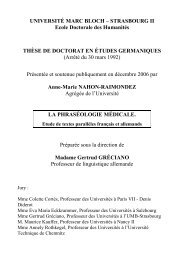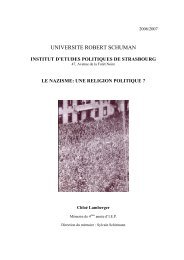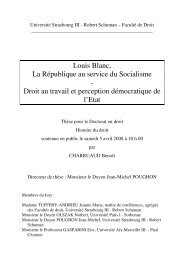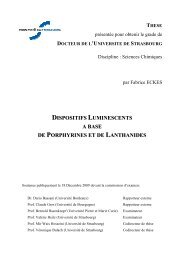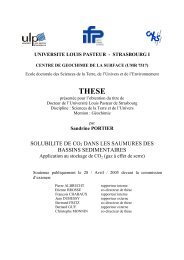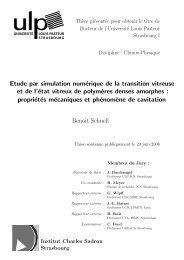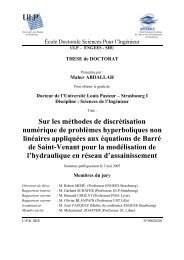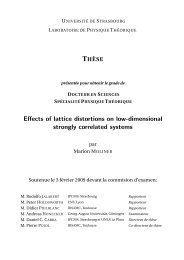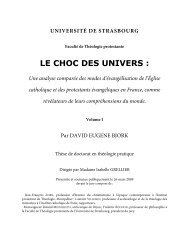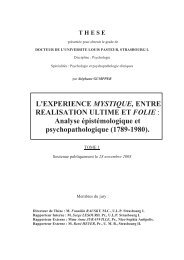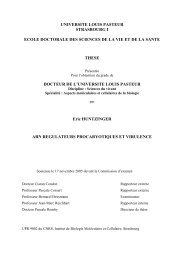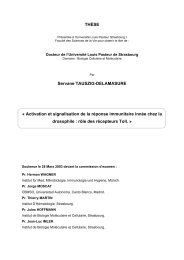Anthony KERMAGORET - THESES ET MEMOIRES DE L'UDS
Anthony KERMAGORET - THESES ET MEMOIRES DE L'UDS
Anthony KERMAGORET - THESES ET MEMOIRES DE L'UDS
Create successful ePaper yourself
Turn your PDF publications into a flip-book with our unique Google optimized e-Paper software.
Chapitre IV<br />
The analysis of the different C6 oligomers was performed in order to differentiate between a<br />
chain growth mechanism and the reinsertion of butenes. The formation of 2-hexene, 3-<br />
hexene and 2-ethyl-1-butene by reinsertion of 1-butene and the formation of 3-methyl-2-<br />
pentene and 3-methyl-1-pentene by reinsertion of 2-butene depending on the insertion mode<br />
(2,1- or 1,2-insertion) has been discussed previously. 27 Isomerization of 1-hexene leads to the<br />
formation of 2-hexene and 3-hexene.<br />
3.1 Use of AlEtCl2 as cocatalyst.<br />
Complexes 17, 18 and 20-22 have been tested in the presence of 2, 4 or 6 equivalents<br />
of AlEtCl2 (Al/Ni ratios of 2, 4 or 6, respectively) and the catalytic results are presented in<br />
Table 3 and shown in Figures 4-6.<br />
The highest activities were obtained for complex 18 with turnover frequencies (TOF) of<br />
78200 and 91200 mol C2H4/(mol Ni·h), either with 4 or 6 equivalents of AlEtCl2,<br />
respectively. Complexes 17, 20, 21 and 22 had similar activities (Figure 4), which increased<br />
with the amount of cocatalyst, between 17000 and 20400 mol C2H4/(mol Ni·h) with 2<br />
equivalents of AlEtCl2, 43500 and 46700 mol C2H4/(mol Ni·h) with 4 equivalents and 56600<br />
and 63600 with 6 equivalents However, 20 showed very low activity with 2 equivalents of<br />
AlEtCl2 (1100 mol C2H4/(mol Ni·h)).<br />
The selectivity for 1-butene was modest and less than 17% for all the complexes<br />
except for 20 with 2 equivalents of AlEtCl2 (72%, Figure 6). The high concentration of 2-<br />
butene indicates that isomerization of 1-butene is largely favored. The exothermicity of the<br />
catalytic reaction (temperature up to 115 °C) with very active systems is most likely<br />
responsible for the lower selectivity in 1-butene. 70 The selectivities for C4 olefins were<br />
between 97% and 50% for complexes 17, 18 and 20-22 (Figure 5) and this showed that<br />
dimerization is much favored over chain growth. The second largest is constituted by the<br />
hexenes (Table 3) with the reinsertion of 1-butene and 2-butene being very significant on the<br />
basis of the branched olefins formed (Table 4).<br />
Increasing the amount of AlEtCl2 had a significant influence on the catalytic results<br />
by forming a more active but less selective system. Higher activities were associated with an<br />
increasing isomerization of 1-butene to 2-butene. With 18, for example, the fraction of 1-<br />
butene decreased from 13% to 2%. The higher concentration of 2-butene favored its<br />
reinsertion to give C6 oligomers (Table 4).<br />
12



